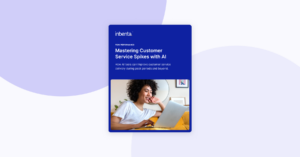Learn the top 5 pitfalls when scaling enterprise AI agents and practical strategies to avoid them. Insights from BCG, McKinsey, Deloitte, IBM, and more.
Enterprise AI agents are moving from concept to production across industries, but scaling them remains one of the most persistent challenges business leaders face. While early proofs-of-concept can show promise, scaling AI agents across multiple workflows, business units, or customer touchpoints can be tricky.
Recent research from leading firms such as BCG, McKinsey, Deloitte, IBM, and others shows that the majority of enterprise AI initiatives are still failing to produce repeatable, durable value at scale. Below are the five most common pitfalls that leaders face and practical guidance on how to avoid them.
Pitfall #1: Misalignment Between Business Value & Agent Strategy
Despite the hype surrounding agentic AI, most enterprises still struggle to move past proofs of concept. According to a Boston Consulting Group global report, 74% of companies struggle to scale AI beyond pilots.
This misalignment shows up in several ways:
- Teams deploy an agent because it’s “the next AI thing,” not because it solves a real business problem.
- KPIs are undefined or unclear.
- The organization doesn’t agree on what success means, so momentum stalls.
- Leadership treats the agent as a tech experiment rather than a business transformation.
Without a shared strategic foundation, scaling is nearly impossible.
How to avoid this pitfall
Start with a business-first problem statement: What job is the agent doing?
Before building anything, define the specific business outcome the agent is responsible for, whether that’s resolving a customer issue, automating an internal workflow, or improving decision quality. A crisp, business-first problem statement keeps teams aligned and prevents the solution from drifting into a tech experiment.
Define measurable KPIs upfront (e.g., reduction in handling time, increase in self-service rate, cost-to-serve savings).
Success metrics should be clear before a single line of code is written so teams know exactly what “good” looks like. Establishing KPIs early also ensures the agent can be monitored, optimized, and governed with data — not assumptions.
Build cross-functional alignment early across operations, compliance, IT, and CX.
AI agents touch multiple systems and teams, so alignment needs to happen before development begins. Engaging stakeholders early means fewer changes later on, accelerates approvals, and ensures the solution is the right fit for your operations, regulations, and customer experience.
Treat agents as enterprise products, not prototypes.
Successful AI agents behave like long-term assets, not short-lived pilots. Giving each agent a product owner, operating budget, release plan and guardrails lets you scale them safely and sustainably.
Pitfall #2: Weak Governance, Security Gaps & “Uncontrolled Autonomy”
Agentic systems differ from legacy automation because they do more than just predict — they act. They interact with systems, execute tasks, make decisions, trigger workflows, and coordinate with other agents or humans. That shift introduces entirely new categories of risk.
A 2025 McKinsey analysis highlights three challenges enterprises face when scaling agentic systems:
- New kinds of risk and autonomy.
- Balancing custom and off-the-shelf agents,
- Keeping up with accelerating AI capabilities.
Meanwhile, Deloitte warns that without a structured governance framework or an enterprise-wide “agent marketplace,” organizations risk agent sprawl, inconsistent security policies, and dangerous autonomy — in short, an AI agent that acts in ways you don’t want.
How to avoid this pitfall
Define role-based access controls for AI agents, identical to human identity governance.
AI agents should follow the same permissions model as human employees, with clearly defined roles, access levels, and approval workflows. This makes sure your AI agents can only act within authorized boundaries and prevents unintended access to sensitive systems or data.
Establish a cross-functional AI Governance Board before scaling beyond one or two pilots.
As soon as you move past early pilots, governance can no longer be informal or ad hoc. A dedicated board spanning legal, security, IT, operations, and CX ensures that every agent meets your organization’s standards for safety, compliance, and business value.
Implement guardrails: action limits, human review triggers, fallback paths, and anomaly monitoring.
Operational guardrails keep agents predictable by limiting what actions they can take and when humans need to intervene. Combined with safe fallback behaviors and anomaly detection, these controls prevent small issues from escalating into big problems.
Ensure full observability: logs, audit trails, and monitoring behavior for every agent action.
Comprehensive observability lets your teams understand, trace, and explain exactly what an agent did — and why. This level of visibility is critical for debugging, compliance, risk management, and continuously improving how your agent performs.
Centralize agent registration so every agent is known, vetted, and owned.
A centralized registry prevents any “shadow agents” from operating outside of your formal oversight and accountability framework. Every agent should have a documented owner, a purpose, configuration, and compliance status before it goes live.
Pitfall #3: Data Silos, Fragmented Integrations & Workflow Bottlenecks
Even the most capable agent fails if it can’t access the data, systems, or context it needs to act. This is the most commonly cited bottleneck across enterprise AI scaling efforts.
IBM’s analysis of agent deployments in government and enterprise notes that data complexity and silos remain top barriers, particularly when agents are interfacing with legacy systems and data that’s outdated or inconsistent.
How to avoid this pitfall
Know your data when you’re planning your AI agent, not after you deploy.
A clear understanding of where your data lives, how it’s structured, and who owns it is essential before any agent is designed. Doing this upfront avoids costly rework and ensures that the agent can access the information it needs from day one.
Prioritize unified data.
Centralizing your data through shared layers keeps it from becoming fragmented and reduces the complexity across your agent ecosystem. This approach lets each agent tap into consistent, governed data without rebuilding pipelines every time.
Use a platform with a built-in knowledge engineering system.
This approach, taken by Inbenta AI, removes the need to manually build custom integrations for every data source (like CRMs, ERPs, or websites), greatly speeding up deployment and reducing maintenance.
Implement a solution that continuously synchronizes with your underlying data.
This keeps your AI agent always operating with real-time accuracy and eliminates the need to constantly refresh your information manually.
Pitfall #4: Over-Customization, One-Off Pilots & the “Prototype Trap”
Many enterprises build highly customized agents for one business unit or workflow. These succeed in isolation but collapse when you try to scale the.
McKinsey, Deloitte, and others point to over-customization as the biggest structural barrier to enterprise-wide agent deployment. When each agent is built differently — different prompts, data pathways, integrations, compliance models — cost, risk, and maintenance needs explode.
How to avoid this pitfall
Deploy an enterprise agent platform, not standalone agents.
Building agents one at a time creates fragmentation and slows down every future deployment. A shared platform, like Inbenta AI, provides a common infrastructure, governance, and tooling that lets you scale safely and cost-effectively across the organization.
Create agent templates so new agents are 60–80% pre-built.
Templates give your teams a head start by providing preconfigured workflows, guardrails, integrations, and evaluation logic. This lets you deploy new agents faster, with fewer errors and more consistent behavior.
Invest in orchestration rather than one-off logic.
Centralized orchestration allows agents to coordinate actions, exchange context, and work together in predictable ways. And it prevents the chaos of ad hoc logic so your agents operate as a cohesive system rather than isolated tools.
Pitfall #5: Cultural Resistance, Workflow Misalignment & Low Adoption
As one recent analysis describes it, technology isn’t the main barrier to scaling agentic AI — organizational readiness is.
Implementation challenges often start when employees distrust a new system or feel threatened by its. This uncertainty gets magnified when teams don’t understand how the agent will change their roles or daily workflows. As a result, users may find ways to bypass the agent and return to familiar manual processes. It’s a problem that’s frequently rooted in leadership underestimating the need for proper training and change management.
How to avoid this pitfall
Involve frontline users early in defining agent workflows.
Frontline employees know where friction lives and which tasks could genuinely benefit from automation. Bringing them in early leads to better-designed workflows, higher adoption, and fewer surprises at rollout.
Provide AI literacy programs focused on collaboration with agents.
Teams need to understand not just what agents do, but how to work alongside them effectively. Training that demystifies AI and focuses on practical collaboration increases confidence and reduces resistance.
Build explicit change-management plans, including communication, training, and feedback loops.
Successfully deploying an AI agent is more than just a technical project. It also takes an organizational shift. Clear communication, targeted training, and fast feedback cycles let people stay informed, supported, and engaged through the transition.
Measure adoption, not just accuracy or output.
Even a high-performing agent fails if teams don’t use it. Adoption metrics highlight where behavior, training, or workflow redesign need attention to realize the full business value of your enterprise AI agent.
Conclusion: Scaling AI Agents Requires Enterprise Thinking
Scaling enterprise AI agents is not primarily a technical problem. It’s a business alignment, governance, integration, architecture, and cultural transformation challenge.
Organizations that successfully scale agents:
- Start with business-driven use cases
- Build governance and observability early
- Invest in knowledge engineering
- Standardize agent components
- Treat change management as a first-class priority
As reports from BCG, McKinsey, Deloitte, IBM, and others make clear, agentic AI is now entering a new maturity stage. Enterprises that understand and apply its best practices early will build a durable and valuable strategic advantage.
FAQ: How to Avoid Common Pitfalls When Scaling Enterprise AI Agents
- Why do most enterprise AI agents fail to scale beyond early pilots?
- Most AI agents stall after the proof-of-concept phase because they lack a clear business objective, measurable KPIs, and alignment across the organization. Without a shared definition of success or an agreed-upon operating model, early enthusiasm can give way to fragmentation, stalled momentum, and solutions that never mature beyond the experiment phase.
- What’s the biggest strategic mistake organizations make when deploying AI agents?
- The most common mistake is treating AI agents as technical prototypes rather than enterprise products. When agents are built in isolation — without a product owner, roadmap, KPIs, or governance — they become difficult to maintain, even harder to scale, and disconnected from the business outcomes they’re meant to drive.
- How does governance help prevent “uncontrolled autonomy” in agentic systems?
- Governance ensures that agents operate within approved boundaries. With role-based access controls, guardrails, audit logs, review triggers, and a cross-functional AI Governance Board, organizations can manage risk proactively and keep agents predictable and compliant.
- Why are data silos such a major barrier to scaling AI agents?
- Even highly capable agents fail if they can’t access the data, systems, or context they need to act. Fragmented data and legacy integrations force teams to redo work, reduce accuracy, and slow deployments. Unified, governed data layers — and platforms with strong knowledge engineering — give agents the consistency and clarity needed to operate reliably.
- What is the “prototype trap,” and why is it so common in enterprise AI?
- The prototype trap occurs when organizations build one-off, heavily customized agents that work well in a single workflow but can’t scale across the enterprise. Each agent ends up with its own prompts, integrations, and compliance model. Standardization, templates, and a shared platform help break this cycle.
- How can organizations increase adoption and trust among frontline employees?
- Adoption rises when employees are involved early, understand how the agent supports their work, and feel equipped to collaborate with it. Clear communication, AI literacy programs, workflow co-design, and ongoing feedback loops reduce resistance and build confidence.
Transform your customer experience with enterprise AI agents.
Inbenta AI is deployed worldwide by companies across industries to intelligently automate customer service, marketing and sales, and internal operations.












